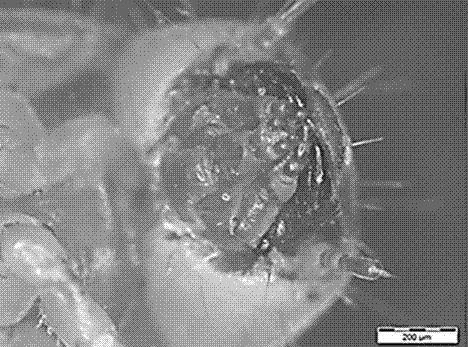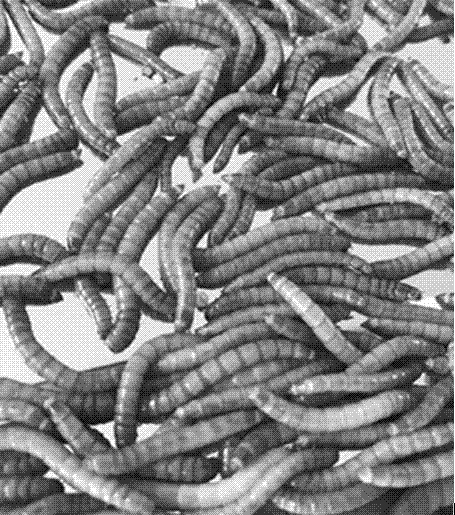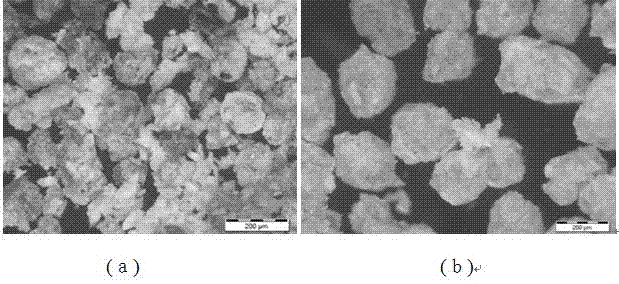Method of degrading waste film materials through yellow meal worms
A technology for Tenebrio molitor and membrane material, applied in the field of Tenebrio molitor degrading waste membrane materials, can solve the problems of harming the surrounding environment, high cost, low recovery and regeneration rate, etc., and achieve the effects of good consumption capacity, reduced molecular weight, and obvious effect.
- Summary
- Abstract
- Description
- Claims
- Application Information
AI Technical Summary
Problems solved by technology
Method used
Image
Examples
Embodiment 1
[0034] A method practice for biodegrading waste membrane materials, specifically comprising the following steps:
[0035] (1) Preparation of waste membrane materials: After washing and fully drying the waste polyvinyl chloride (PVC) membrane materials from the sewage / wastewater treatment plant, divide them into sheets with a cutter, and spread them evenly on the The bottom of the container for cultivating Tenebrio molitor is set aside.
[0036] (2) Preparation of raw material Tenebrio molitor: put the insect body purchased from Shanghai Tenebrio molitor farm in a constant temperature incubator, and add enough feed to activate the activity of Tenebrio molitor. Three days later, the molting that may carry insect feces is removed by a hair dryer, and healthy Tenebrio molitors of similar size are screened out for use.
[0037] (3) Preparation of culture conditions: evenly put the Tenebrio molitor screened in step (2) into a constant temperature incubator, and cover part of the wa...
Embodiment 2
[0041] Sampling Tenebrio molitor after the end of the balance cycle, and observed with a stereomicroscope after pretreatment and dissection, the specific operation process of pretreatment and dissection is as follows: Soak Tenebrio molitor larvae in ethanol for 2 hours and freeze-dry them for 24 hours, so that the intestinal tract of mealworms It can be easily detached from other tissues, and then use a scalpel to remove the head from the second section behind the head of the worm, use tweezers to take out the entire intestinal tract in the worm, and observe it under a stereoscopic microscope. The photo was taken and the result is as Figure 4 shown. It can be observed that there is ingested waste PVC membrane material in the intestinal tract of Tenebrio molitor.
Embodiment 3
[0043] During the feeding cycle, another mealworm degradation unit was used to add wheat bran as the only auxiliary feed to investigate the effect of wheat bran on the degradation of waste PVC film materials by Tenebrio molitor. The amount of wheat bran added was 20% of the insect weight ~25% / 5d, the consumption rate of waste membrane materials is as follows Figure 5 As shown, under the condition that the initial number of insects is 400 and the initial plastic mass is about 6.8g, after 39 days, the mass of film material consumed by the Tenebrio molitor group with waste polyvinyl chloride film material as the only food is about 4.1g. g, Tenebrio molitor group with added wheat bran consumed about 5.3 g of waste PVC membrane materials, which indicated that adding wheat bran was beneficial for Tenebrio molitor to consume waste PVC membrane materials. As auxiliary feed, wheat bran provided Tenebrio molitor with a small amount of water, extra sugar and trace elements, thereby improv...
PUM
| Property | Measurement | Unit |
|---|---|---|
| Number average molecular weight | aaaaa | aaaaa |
| Weight average molecular weight | aaaaa | aaaaa |
Abstract
Description
Claims
Application Information
 Login to View More
Login to View More - R&D
- Intellectual Property
- Life Sciences
- Materials
- Tech Scout
- Unparalleled Data Quality
- Higher Quality Content
- 60% Fewer Hallucinations
Browse by: Latest US Patents, China's latest patents, Technical Efficacy Thesaurus, Application Domain, Technology Topic, Popular Technical Reports.
© 2025 PatSnap. All rights reserved.Legal|Privacy policy|Modern Slavery Act Transparency Statement|Sitemap|About US| Contact US: help@patsnap.com



